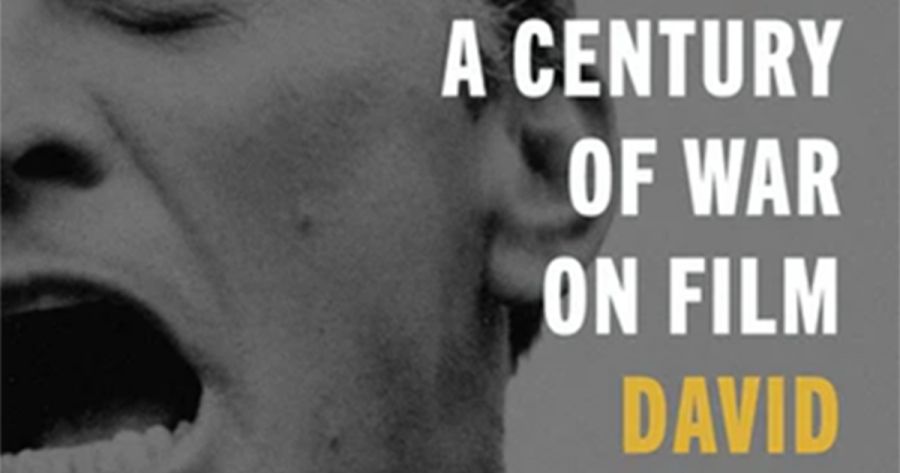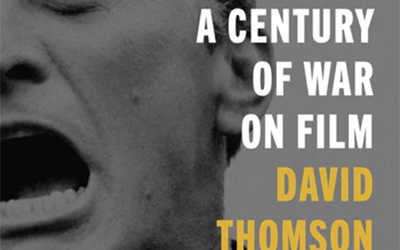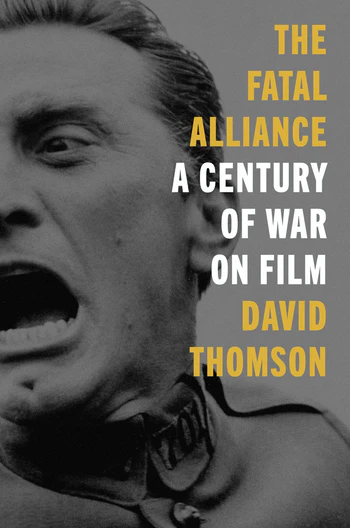
- Free Article: No
- Contents Category: Film Studies
- Review Article: Yes
- Article Title: Ready. Aim. Shoot.
- Article Subtitle: Rehearsing the end of the world
- Online Only: No
- Custom Highlight Text:
Film critic’ rather undersells the breadth and depth of David Thomson’s engagement with the medium. A distinguished historian, biographer, novelist, and encyclopedist of film, he has also made documentaries, written screenplays, and been a respected judge on the international film festival circuit. He is widely regarded as the greatest living writer on film. It is fitting, then, that after more than twenty books on cinema he has finally turned his attention to war, a matter whose scope and import across the history of film provides a true match for his gifts.
- Featured Image (400px * 250px):

- Alt Tag (Featured Image): Kevin Foster review ‘The Fatal Alliance: A century of war on film’ by David Thomson
- Book 1 Title: The Fatal Alliance
- Book 1 Subtitle: A century of war on film
- Book 1 Biblio: Harper, $35 hb, 457 pp
- Book 1 Cover Small (400 x 600):

- Book 1 Cover (800 x 1200):

A patient if sometimes salty guide, Thomson leads the reader through some of war cinema’s most celebrated monuments, pointing out their architectural merits and solid construction, while peeling back the façade on others to reveal rotten foundations of lies and silences. In historical and geographical terms, the tour does not take us all that far – from an extended stay in the Europe of the two world wars, to Vietnam, with a side trip to Mogadishu. Further, the journey is principally routed through the United States, and Hollywood, whose preoccupations and industry imperatives did so much to shape the world’s view of these conflicts. But the moral and psychological distance covered is colossal. Probing the cinematic treatments of the world wars, rejecting Hollywood’s more anaesthetising bromides, Thomson lays bare the frail certainties and vain heroism of so much war cinema for the whistling in the dark that it is, drawing the reader ever closer to the terrors that flicker at the fringes of the camera’s footage and crowd the corners of the brain.
The book’s central conceit is that war and cinema are Siamese technologies, that ‘world war and world cinema came into being in the same burst of change. Like an explosion.’ Their language, the organisation of their technologies and personnel, even their aims are interwoven. In both, resources are mobilised, participants are gathered, costumed, marshalled, choreographed, and finally called forward by their commanders. The machinery is locked and loaded. Ready. Aim. Shoot.
This technical and linguistic symbiosis reflects one of Thomson’s key arguments, that cinema is more war’s enabler and accomplice than its mirror and scourge. War films, especially the modern, CGI-enhanced variety, as witnessed in 1917 (2019) and All Quiet on the Western Front (2022), seek to transport the audience onto the battlefield, amid the mud and blood, the suffering and dying, the blighting of lives and the blasting of worlds, assuring them, ‘Look, you are there, all of this is happening’, while never removing them from the comfort of their seats. The ‘panoramas of ruin’ that ensue are made all the more sublime by the audience’s consistent realisation of their artifice. Such effects, Thomson notes, open ‘a gulf of taste between slaughter and composure’. Put simply, audiences can too readily enjoy the vicarious thrill of the battlefield without being required to imagine, let alone suffer, its terrors or its lasting debilitations. As a result, war films, even – sometimes especially – anti-war films, are inescapably celebratory, their moral posturing under-pinned and undermined by fantasies of heroic virtue and a pornography of armaments: ‘In the dark, whatever the official motive or the orders, we go to war for excitement.’
Jean Renoir, director of La Grande Illusion (1937), hoped that ‘movies could save the world’. Thomson argues that they are far more likely to hasten its destruction. As time has passed since the end of the world wars and as the eyewitnesses to their horror have died off, the algorithms which bloat us with information have narrowed the pathways to a richer understanding of the experience of combat and have blocked the impulse to empathy with its victims. In this context, Thomson laments the fact that ‘the most available sense of history is reappraisal through a movie’. Movies are ‘rarely adequate as history’, not least because the expense involved in their making requires their producers to feed the public ‘a few tasty white lies’ to make sure they recover their investment. So where does this cocktail of falsehood and ignorance leave us? ‘If we let the movies be our history book,’ Thomson cautions, ‘we will only repeat the movies.’ But in this replay the fallen do not get to rise again once the director calls ‘cut’.
Central to popular cinema’s vision of the past is the simplified moral terrain of so many of its battlefields. Here, valour triumphs, certainty overpowers doubt, good prevails, and a benevolent postwar order is permanently set in place. The films that draw Thomson’s appraising eye – Life and Nothing But (1989), Go Tell the Spartans (1978), The Human Condition (1959-61), Bad Day at Black Rock (1955), Act of Violence (1948) et al. – problematise or push back against these complacent certitudes, refusing to accept that all wounds heal, that the fighting is ever really over, or that war delivers the just settlement that its victors promised.
Though the movies have customarily portrayed combat as ‘a field for courage and its prowess’, wars are fought by people in a state of almost constant terror. This is a truth, Thomson believes, that the cinema should not only acknowledge but honour. The real hero of Steven Spielberg’s Saving Private Ryan (1998), he proposes, is not Tom Hanks’s noble everyman, Captain Miller, but the hapless translator, Corporal Upham, whose shuddering fear leaves him utterly helpless: ‘This is a man so true to life and terror; he deserves a medal. Or a whole movie about how he made his way in peace.’
It wasn’t only Hollywood. Things were no better at Pinewood Studios. As Britain struggled through rationing and the glacial advance to promised prosperity, its postwar cinema was ‘boisterous, cocksure, often foolish’. The year 1955 alone saw the release of The Dam Busters, The Colditz Story, and Above Us the Waves – films ‘loaded with syrup to pour over the suet pudding of abashed morale’. Contemplating this theatre of bombast, Thomson sagely reflects: ‘Sometimes bad films tell you more about the country that made them than the masterpieces.’
The English-speaking cinema’s swagger, Thomson argues, was born of ignorance of just how bad things could get, the result of neither modern Britain nor the United States ever having known ‘the adult dismay’ of occupation. By contrast, he applauds the ‘daunting honesty’ of The Sorrow and the Pity (1969). Marcel Ophüls’s unflinching exposure of the humiliations and compromises imposed by the Nazi occupation of France is propelled by its insistent – if unspoken – question: ‘What would you have done?’ In this light, Thomson argues, ‘all modern war finds its pathos and its fatal knowledge in Russia’, where conflict wreaked its greatest destruction and visited its most lacerating indignities on the population. The best Russian cinema, like Larisa Shepitko’s The Ascent (1977), faces up to and anatomises the evil that attends on collaboration, the failure of human conscience it exposes and the spiritual corruption it breeds.
The deeper failure of cinema’s treatment of war over the past century, Thomson believes, lay in its refusal to accept and advertise the deflating truths about us that conflict revealed, that ‘we were – and will be – craven, corrupt, treacherous and human’. Instead, the movies proffered ‘a pattern of lies’, from which it constructed ‘a dreamworld of battle stories, as if we might be ennobled by them. Or saved in victory.’ The consequences of this childish make-believe could be fatal for us all. While US and British cinema persistently circles back to the ‘garden-party exuberance’ of films about D-Day and Dunkirk, they wilfully ignore the fact that ‘between 1939 and 1945 we rehearsed the end of the world’.
Cowering from the bombs in his London home, the little boy who spent a lifetime sitting in the dark, witnessing cinema’s endless battle with the truth about war, knew from his earliest days where this drama might yet end.


Comments powered by CComment